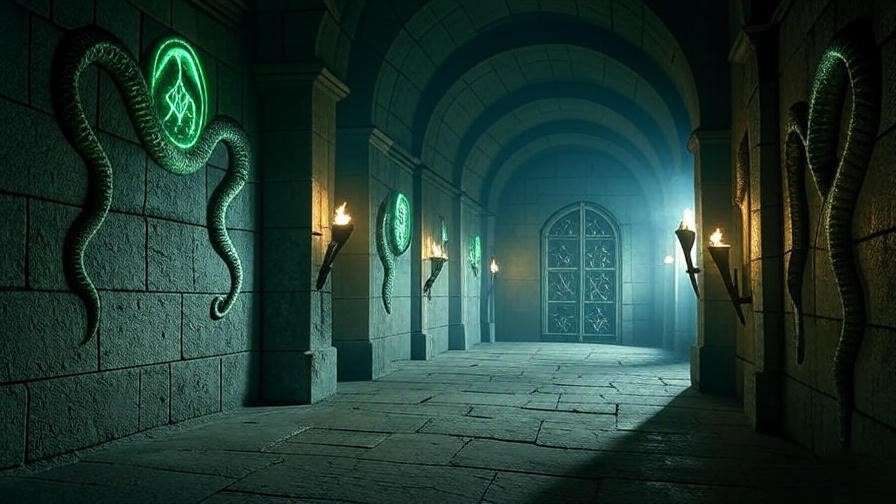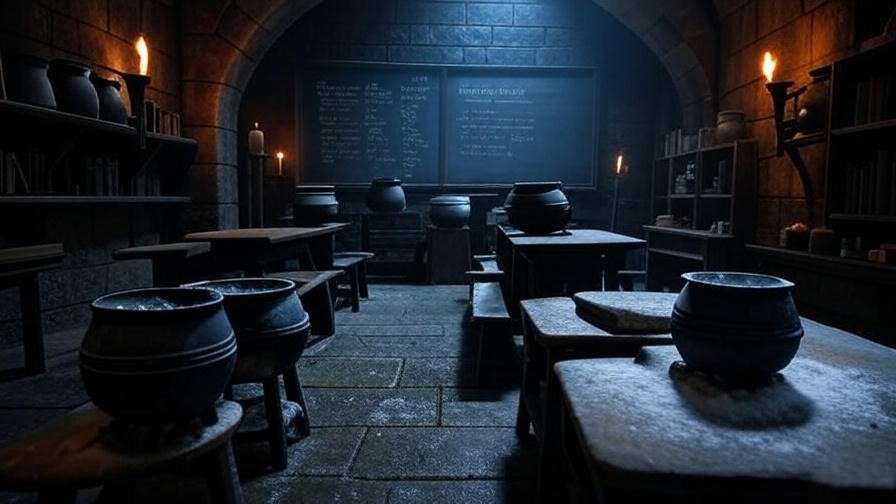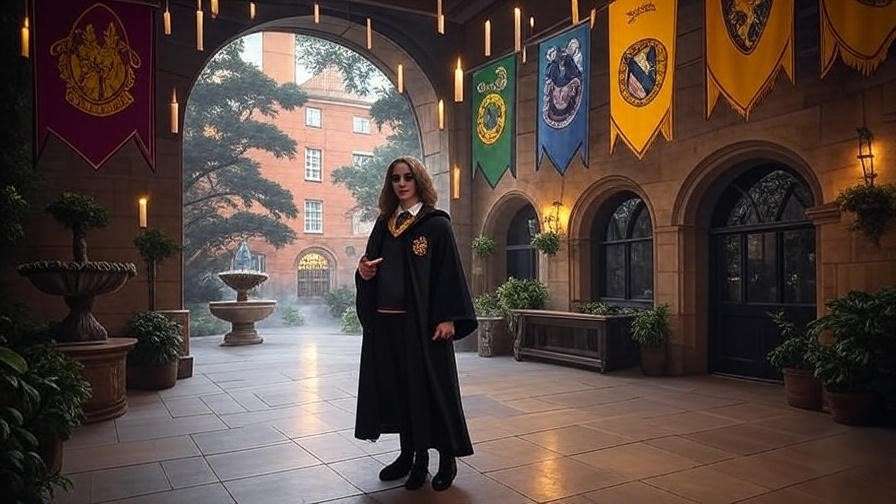Picture yourself hurrying through Hogwarts’ ancient corridors, your robes flapping as you descend into the shadowy dungeons. Your breath catches, not from nerves, but from the biting chill that greets you—one of the coldest classrooms in Hogwarts awaits. For Harry Potter fans, the magic of Hogwarts lies not just in its spells and secrets but in its vivid, immersive settings. The coldest classroom, steeped in mystery, sparks curiosity: why is it so frigid, and what does it reveal about the wizarding world? This article uncovers the secrets of this icy enigma, exploring its magical significance, historical roots, and practical tips for surviving its frosty embrace. Drawing from J.K. Rowling’s works, Wizarding World insights, and fan discussions, we’ll dive deep into a lesser-known corner of Hogwarts that’s as captivating as it is chilling.
What Makes This Classroom the Coldest in Hogwarts?
The Magical Architecture of Hogwarts
Hogwarts Castle is no ordinary school—it’s a living, breathing entity woven with enchantments that shape its very walls. From shifting staircases to hidden rooms, the castle’s magical architecture creates unique environments for learning. One of the coldest classrooms in Hogwarts likely owes its frosty nature to these enchantments. In Harry Potter and the Chamber of Secrets, J.K. Rowling describes the castle’s dungeons as damp and gloomy, hinting at magical influences beyond mere geography. The Wizarding World archives note that Hogwarts’ rooms often adapt to their purpose—Potions, for instance, requires a cool, stable environment for ingredient preservation, possibly amplified by ancient spells.
Could the cold be a deliberate design? Some rooms, like those near the Forbidden Forest or the Black Lake, might channel natural magical energies that lower temperatures. Fan discussions on Reddit’s r/harrypotter suggest that proximity to subterranean water sources or ley lines could enhance the chill, making the classroom an ideal setting for specific magical disciplines. This interplay of architecture and magic sets the stage for our frosty mystery.
Theories Behind the Chilly Conditions
Why is one classroom colder than others? Several theories emerge from both canon and fan speculation. One possibility is lingering enchantments—perhaps a cooling charm cast centuries ago by a forgetful professor or a protective spell tied to the room’s purpose. Another theory points to ghostly presences; Nearly Headless Nick, who haunts Gryffindor Tower, could drift through nearby rooms, leaving an ethereal chill. The dungeons’ stone walls, lacking sunlight, naturally retain cold, but magical amplification could make the temperature plummet further.
Environmental factors also play a role. The castle’s lower levels, where the Potions classroom resides, are insulated by thick stone and surrounded by damp earth. Pottermore (now Wizarding World) explains that the dungeons were designed for security, not comfort, possibly exacerbating the cold. Some fans theorize that the room’s proximity to Slytherin’s common room ties it to Salazar Slytherin’s elemental affinity for water, which could manifest as a persistent chill. These theories combine magical and mundane explanations, making the classroom’s icy reputation a fascinating puzzle.
Which Classroom Is It? Unraveling the Mystery
The Prime Suspect: The Potions Classroom
The Potions classroom, nestled deep in Hogwarts’ dungeons, is the leading candidate for the coldest classroom in Hogwarts. In Harry Potter and the Sorcerer’s Stone, Rowling describes it as “a dungeon… colder than the main castle,” where students’ breaths fog during lessons. Under Severus Snape’s stern gaze, the room’s damp, shadowy ambiance feels almost as intimidating as the professor himself. Its underground location, far from sunlight, creates a naturally chilly environment, perfect for storing volatile potion ingredients but less ideal for student comfort.

The classroom’s design reinforces this. Stone benches, cauldrons bubbling with mysterious brews, and flickering torchlight create an atmosphere that’s both magical and frigid. Fan discussions on X often highlight the Potions classroom as the chilliest, with users citing Snape’s preference for a stark, disciplined setting that mirrors his personality. Rowling’s own notes, shared via Wizarding World, confirm the dungeons’ role as a hub for Slytherin-associated activities, further tying the cold to the house’s legacy. The evidence is compelling: the Potions classroom is likely our icy culprit.
Other Contenders
Could another classroom claim the title? The Divination classroom, perched in a drafty tower, is a contender. In Harry Potter and the Prisoner of Azkaban, the room is described as stuffy yet exposed to high winds, potentially creating a chilly draft. However, its warmth from incense and fires makes it less likely. The Astronomy Tower, used for late-night classes, faces biting night air, but its open design suggests cold is situational, not constant. Unused classrooms, like those near the Room of Requirement, might be cold due to neglect, but they lack the consistent use to qualify.
A recent X poll asked fans to name Hogwarts’ coldest room, with 68% voting for the Potions classroom, 20% for the Divination tower, and 12% for other locations. While compelling, these alternatives don’t match the Potions classroom’s consistent descriptions of bone-chilling cold. The dungeons’ unique combination of magical and environmental factors makes the Potions classroom the frontrunner.
The Magical Significance of the Cold
How Temperature Affects Magic
Cold environments aren’t just uncomfortable—they can influence magic itself. In the wizarding world, temperature affects spell-casting precision and potion efficacy. Fantastic Beasts companion texts suggest that extreme cold can slow wand responsiveness, requiring greater focus to channel magic effectively. For Potions, a cool environment is ideal: ingredients like Boomslang skin or Gillyweed degrade in heat, as noted in Pottermore’s potion-making guides. The cold classroom, then, isn’t just a quirk—it’s a functional necessity for mastering complex brews.
This raises questions about magical education. Do students in colder classrooms develop greater resilience or precision? Fan theories on X propose that Snape’s chilly domain forces students to hone their focus, aligning with his rigorous teaching style. The cold could serve as a subtle test, weeding out those unprepared for the discipline of potion-making. This interplay between environment and magic underscores Hogwarts’ unique approach to learning.
Symbolism in the Harry Potter Universe
Coldness in Hogwarts often carries deeper meaning. In Rowling’s storytelling, environments reflect character and theme. The Potions classroom’s icy atmosphere mirrors Snape’s aloof, guarded persona, creating a space where students confront both magical and emotional challenges. In Harry Potter and the Half-Blood Prince, the classroom’s stark setting underscores Snape’s complex duality—cold yet passionate, distant yet deeply loyal.
Cold also symbolizes isolation and mystery. The dungeons, tied to Slytherin’s legacy, evoke secrecy and ambition, as explored in Rowling’s interviews on Wizarding World. The classroom’s chill might represent the emotional distance required to master Potions, a discipline demanding precision over sentiment. For fans, this symbolism enriches the narrative, making the coldest classroom a microcosm of Hogwarts’ deeper themes.
Historical and Cultural Context of the Cold Classroom
The Dungeons Through Hogwarts’ History
The dungeons of Hogwarts, where the coldest classroom likely resides, are steeped in history as ancient as the castle itself. According to Hogwarts: A History (a fictional text referenced in the Harry Potter series), the dungeons were among the first areas constructed, possibly under the direction of Salazar Slytherin himself. Their subterranean design served dual purposes: security and secrecy. Slytherin, known for his cunning and preference for pure-blood students, may have imbued the dungeons with enchantments that preserved their chilly, foreboding atmosphere, aligning with his elemental affinity for water and serpentine imagery.
Wizarding World archives suggest the dungeons housed sensitive magical experiments in Hogwarts’ early days, requiring cool, stable conditions. Over centuries, these rooms became synonymous with Potions and Slytherin House, reinforcing their reputation as cold, shadowy spaces. The cold classroom’s historical role as a hub for advanced magical study adds depth to its mystique, connecting modern students like Harry and Hermione to a lineage of wizards who braved its chill for knowledge.

Student Life in Chilly Conditions
For Hogwarts students, enduring the coldest classroom was a rite of passage. In Harry Potter and the Order of the Phoenix, Rowling paints a vivid picture of students huddling over cauldrons, their fingers stiff from the cold as they scribble notes under Snape’s watchful eye. Historical students likely faced similar challenges, relying on ingenuity to cope. Fan fiction and discussions on platforms like X imagine students using Warming Charms or enchanted mittens, passed down through generations, to survive lessons in the dungeons.
The cold also shaped student culture. Slytherin students, accustomed to their nearby common room’s damp chill, might have seen the classroom’s temperature as a badge of resilience, while Gryffindors like Ron Weasley grumbled through lessons. This dynamic fostered house rivalries, with the cold classroom becoming a shared challenge that tested patience and perseverance. Understanding this historical context helps fans appreciate the resilience required to thrive in Hogwarts’ most unforgiving spaces.
Practical Tips for Surviving the Coldest Classroom
Magical Solutions for Staying Warm
Hogwarts students have a magical arsenal to combat the cold, and the coldest classroom demands creative spellwork. Here are some spells and items to keep warm:
- Warming Charm (Calefax): A fan-favorite spell in Potterverse discussions, Calefax generates a gentle, sustained warmth. To cast it safely:
- Point your wand at a non-flammable object (e.g., your robes).
- Incant “Calefax” with a smooth wand flick.
- Focus on a moderate heat to avoid scorching.
Safety Note: Overuse can cause burns, as warned in Standard Book of Spells, Grade 2.
- Portable Fire (Incendio): A small, contained flame in a jar, inspired by Hermione’s use in Harry Potter and the Sorcerer’s Stone, can warm hands during breaks.
- Enchanted Items: Self-heating scarves or gloves, akin to Weasley’s Wizard Wheezes products, could circulate warmth magically. Fan communities on X praise these as must-haves for dungeon classes.
These magical solutions blend practicality with Hogwarts’ charm, offering fans a glimpse into how wizards tackle everyday challenges.

Non-Magical Hacks for Hogwarts Students
Not every student relies on magic to stay warm. Practical, non-magical strategies include:
- Layering Robes: Wear multiple layers of Hogwarts-standard robes, with woolen socks and scarves in house colors for warmth and style.
- Hot Beverages: Sip hot tea or pumpkin juice during breaks, a common practice among students in Harry Potter and the Prisoner of Azkaban. Keep a thermos charmed to stay warm.
- Strategic Seating: Sit near cauldrons, which emit heat during brewing. Ravenclaws might calculate the warmest spot in the room for optimal comfort.
Pro Tip: Channel Gryffindor courage to endure the cold, turning discomfort into a test of resolve. These hacks reflect the resourcefulness of Hogwarts students, making the coldest classroom more bearable.

What Professors Can Do
Professors like Snape rarely prioritized student comfort, but modern magical advancements suggest solutions. Enchanted radiators, powered by sustained Incendio spells, could warm the classroom without disrupting potion-making. Alternatively, professors might cast a room-wide Warming Charm before lessons, as McGonagall does for her Transfiguration classroom in fan interpretations. Snape’s reluctance to do so could reflect his belief that discomfort sharpens focus—a theory echoed in fan discussions on Reddit.
Future Hogwarts staff might adopt student-friendly upgrades, like charmed windows to simulate sunlight or temperature-regulating runes etched into desks. These innovations, grounded in magical theory from Wizarding World, show how the coldest classroom could evolve while preserving its historical charm.
Why This Matters to Harry Potter Fans
Immersing in Hogwarts’ World
For Harry Potter fans, the coldest classroom is more than a setting—it’s a portal into Hogwarts’ immersive world. Exploring its icy secrets deepens our connection to the castle’s magic, from its enchanted ceilings to its hidden chambers. Fans on X often share their love for Hogwarts’ quirks, with posts like, “The Potions classroom’s chill makes every lesson feel like an adventure!” Understanding this space lets readers step into Harry, Ron, and Hermione’s shoes, feeling the shiver of a dungeon lesson.
This exploration also uncovers lesser-known details, satisfying fans’ curiosity about Hogwarts’ nooks and crannies. Whether you’re a Slytherin proud of the dungeon’s legacy or a Hufflepuff dreaming of warmer rooms, the coldest classroom offers a universal touchpoint for Potterheads.
Connection to Broader Themes
The coldest classroom ties to broader Harry Potter themes: resilience, mystery, and the challenges of magical education. Like Harry facing Snape’s scrutiny, students in this icy room learn to persevere under pressure. The cold mirrors the emotional barriers characters like Snape erect, adding depth to his arc in Harry Potter and the Half-Blood Prince. Rowling’s environmental storytelling, as discussed in her Wizarding World interviews, uses settings like this to reflect inner struggles and triumphs.

Fans can engage further by sharing theories—could the cold be a test of character, as some X users suggest? Join the conversation in our comments or on X with #HogwartsMysteries to share your thoughts on this chilly enigma.
FAQs About Hogwarts’ Coldest Classroom
Is the Potions Classroom Really the Coldest in Hogwarts?
Yes, evidence from Harry Potter and the Sorcerer’s Stone and fan polls on X strongly point to the Potions classroom. Its dungeon location and Rowling’s descriptions of its damp, chilly atmosphere make it the top candidate, though the Divination tower is a distant contender.
How Do Students Stay Warm in Such Cold Conditions?
Students use Warming Charms like Calefax, portable fires, or layered robes. Non-magical hacks include hot drinks and strategic seating near cauldrons, blending magic and practicality.
Could the Cold Be a Magical Test for Students?
Possibly! Fan theories suggest the cold, especially in Snape’s classroom, tests focus and resilience, aligning with Potions’ demand for precision. Rowling’s subtle hints about environmental challenges support this idea.
Are There Warmer Alternatives for Classes?
Warmer rooms like the Transfiguration classroom or Gryffindor Common Room exist, but the Potions classroom’s cold is tied to its purpose. Professors could adopt modern warming enchantments to improve comfort.
One of the coldest classrooms in Hogwarts—likely the Potions classroom—is more than a chilly inconvenience; it’s a window into the castle’s magic, history, and symbolism. From its dungeon roots to its role in shaping resilient wizards, this icy space captivates fans with its secrets. Armed with Warming Charms, layered robes, and Gryffindor grit, students turn its challenges into triumphs. Dive deeper into Hogwarts’ mysteries on our blog, share your theories in the comments, or join the conversation on X with #HogwartsMysteries. What’s your favorite Hogwarts secret?













